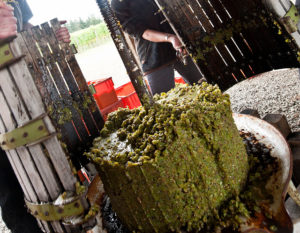
Photo courtesy Flickr user Oregon State University
The winemaking process always yields varying amounts of waste, the disposal of which varies greatly from producer to producer, and from region to region. Some countries have mandated how winery waste (a.k.a. pomace, marc, etc.) is disposed of, though for many it’s less regulated. Winery waste, like any other waste, can become a big environmental problem, so finding ways to reduce, reuse, or recycle this waste is paramount to keeping environmental impact at a minimum.
We’ve covered topics concerning winery waste several times on this site over the years. See the end of this post for links to those articles.
A new study, published in the March issue of Proceedings of the National Academy of Sciences, India Section B: Biological Sciences (though it was available online in 2015, so maybe it’s not that “new”), aimed to add to this list of possible uses for winery waste by evaluating its ability to replace wheat flour in cookies. Yes, cookies. The researchers postulated that using winery waste in the form of grape pomace powder would add significant nutritional beef to cookies, as it is loaded with compounds like flavanols, flavonoids, anthocyanins, phenolic acids, dietary fiber, and lignin.
The overall goal of the study was to simply evaluate the effect of winery waste-based grape pomace powder as a replacement for wheat flour in cookies, specifically related to the chemical and sensory composition of the savory morsels.
Brief Methods

Photo by Flickr user Michelle O’Connell
Pomace from Cabernet Sauvignon grapes were used during this study.
To create the grape pomace powder:
- Pomace was dried in an oven at 45-50oC (113-122oF) for 72 hours.
- Stems and seeds were manually removed.
- Remaining dried pomace was ground and passed through a sieve.
- The resulting powder was used to replace flour in the cookies (specifically, wheat flour in the recipe the researchers used).
Grape pomace powder was added with the other dry ingredients at 5%, 10%, 15%, and 20%. A control was included with no grape pomace powder added.
After baking, cookies were cooled and then stored in plastic bags for later chemical and sensory analysis.
The cookies were analyzed for: color intensity, water absorption capacity, ash (think salty, inorganic elements like potassium, calcium, etc.), anthocyanins, total phenolics, flavonoids, tannins, and antioxidant activity.
Sensory analysis was performed by a team of 40 people (20 women and 20 men). The following characteristics were evaluated for each cookie: color, appearance, aroma, texture, taste, mouth sensation, and overall acceptability. These characteristics were evaluated on a 5-point Hedonic scale.
There were three replicates per treatment.
Selected Results
- Overall, cookies with grape pomace powder added instead of flour were superior to boring regular, I mean control, cookies.
- Grape pomace powder cookies had higher water absorbing capacity (more moist?) than control cookies.
- Grape pomace powder cookies had higher dietary fiber levels than control cookies.
- Grape pomace powder cookies had higher ash content than control cookies.
- The more grape pomace powder added, the greater the ash content.
- Notable increases occurred for: potassium, calcium, magnesium, sodium, iron, manganese, copper, and zinc.
- Grape pomace powder cookies are therefore more “nutrient rich” than control cookies.
- Color intensity was greater for grape pomace powder cookies (they added a dark brown color).
- The more grape pomace powder added, the darker the cookies.
- Grape pomace powder cookies had higher total phenolics, flavonoids, antioxidant activities, tannin, and anthocyanin levels than the control cookies.
- OK, I could have summed up every bullet point above by saying: grape pomace powder cookies had higher levels of everything.
Sensory Analysis
- The cookies with 5% grape pomace powder added received the highest score for most categories, including appearance, texture, mouth sensation, taste, aroma, and overall acceptability.
- Appearance scores: 5%>10%>Control>15%>20%
- Texture scores: 5%>10%>15%>Control>20%
- Mouth sensation scores: 5%>10%>Control>15%>20%
- Taste scores: 5%>10%>Control>15%>20%
- Overall acceptability scores: 5%>10%>Control>15%>20%
- As the concentration of grape pomace powder increased, overall acceptability scores went down (with the control hanging out in the middle).
- The cookies with 20% grape pomace powder received the highest score for color.
- Color scores: 20%>15%>10%>5%>Control

Photo courtesy Flickr user Chief Trent
Conclusions
Overall, the results of this study showed that grape pomace powder could be used as a replacement for [wheat] flour in cookies. More specifically, grape pomace powder at 5% is the ideal concentration for improved sensory characteristics (i.e. the tastiest cookie). What I’m not completely clear about was whether or not the researchers added additional flour in the cookies that had a lower amount of grape pomace powder. They said that “X% was added with dry ingredients”: does this mean that they added X% of the amount of total dry ingredients? Or did they add X% of the original amount of flour? If the original recipe called for 1 cup of flour, did they just replace it with 5%, 10%, 15%, and 20% of that, respectively, for each treatment/batch? Or did they use a 5%/95% (10%/90% etc) grape pomace powder/flour ratio? That was not entirely clear to me. Maybe it’s just because I’m sitting here trying to concentrate with a 1.5-year-old running around and that’s not going too well for me.
What was clear was that a little bit of grape pomace powder goes a long way in terms of yumminess, and in terms of healthiness! So, for all you winemakers looking for something to do with your leftover grape pomace (particularly from your red wines), why not make some cookies with them? According to this study, they are not only tasty, but they are also good for you, too (sugar and fat content, aside…).
While I doubt it could be used as the sole option for disposing of your winery waste, it could make a fun addition to your recycling regime and could be a nice little item to have available in your tasting rooms for your visitors to sample or buy (if you’re legally allowed to sell snacks/food anyway).
And no, this isn’t exactly “important” science, but it is fun, apparently tasty, and is technically another way to help reduce the amount of waste needing disposal in the winery.
Source:
Check out posts on The Academic Wino related to winery wastes here:
Grape Seed Extracts Reduce Formaldehyde Levels in Leather Production
Grape Stem Extracts: An Example of Utilizing Winery Waste for a More Sustainable Industry
Using Grape Pomace as a Additive to Rosé Wines to Improve Wine Quality and Stability
Enzymatic Extracts from Wine Industry Waste May Provide Cardiovascular Benefits in the Rat Model
Using Dehydrated Grape Marc Waste to Improve Wine Quality: A More “Natural” Approach?
Treatment of Grape Marc Using Earthworms Makes Winery Wastes More Suitable for Crop Fertilizer
Wine Industry Waste as a Protein Supplement for Tilapia Feed Diets: Rice Wine Edition
Winery Wastewater and Animal Manure: The New Alternative Fuel Source?

1 comment for “Winery Waste Meets Betty Crocker: Using Grape Pomace Powder As A Replacement for Flour in Cookies”